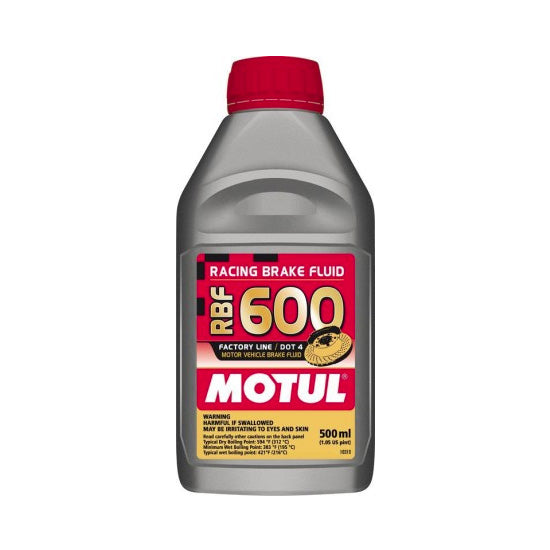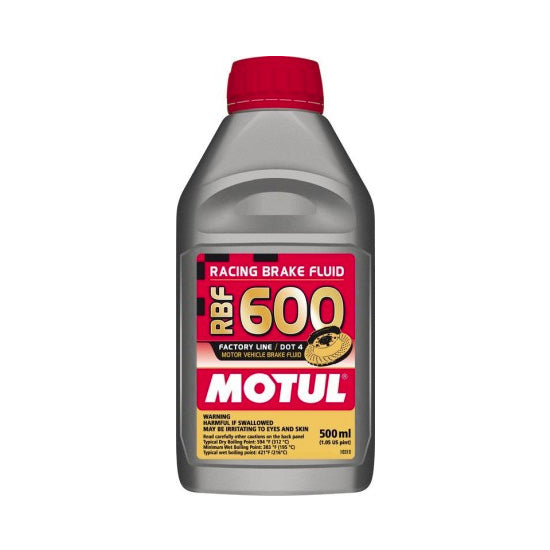Motul
Motul RBF600
Motul RBF600
Prix habituel
$21.95 USD
Prix habituel
Prix soldé
$21.95 USD
Prix unitaire
par
Impossible de charger la disponibilité du service de retrait
Racing Brake Fluid 600 - 100% Synthetic Fluid - DOT 4 -
Extreme high performance polyglycol brake fluid which far exceeds the standards of DOT 4. Each bottle is filled with Nitrogen, increasing shelf life and eliminating contamination while factory sealed. Extremely high dry boiling point of 594℉ (312℃) helps prevent vapor lock and brake fade during hard use, with excellent recovery time.
- Wet boiling point: 420℉ (215℃).
- Super high dry boiling point: Dry 594℉ (312℃).
- 100% synthetic fluid for hydraulic-actuated brake and clutch systems.
- Specifically designed to resist the high temperatures of actuated (steel or carbon) racing brakes and clutch systems.
- Most popular brake fluid on the market.
- Mixes with DOT 3 and 4 systems (Not DOT 5).
Dry boiling point means how the fluid performs brand new from a sealed container.
Wet boiling point is how the fluid performs after being exposed to the moisture in the air and after being in the bike for a long time absorbing moisture.
Is RBF600 right for you?
We know it's difficult to choose parts for your car sometimes, so we thought we'd make it easier by offering a concise selection guide for Motul's brake fluid products
If you only ride your bike on the street, are not overly aggressive on your brakes, or don't want to flush your brake fluid more than once every one to two years, we recommend Motul's DOT 5.1 fluid. It absorbs water very slowly and has high dry and wet boiling points compared to most DOT 3 and DOT 4 fluids.
If you ride your bike aggressively on the street, ride lots with heavy braking or do track days occasionally, Motul's RBF600 is the fluid for you. It will last at least a year under normal street riding conditions before needing to be flushed, and has extremely high dry and wet boiling points - much higher than DOT 5.1.
If you're still boiling Motul's RBF600, it's time to consider RBF660, Motul's highest performing brake fluid. It absorbs water very quickly compared to RBF600 but in exchange has an even higher dry boiling point. If you know you need extreme temperature resistance RBF660Â is the only way to go.
The Details on Motul's RBF600 Brake Fluid
Motul's RBF600 is an excellent balance between extreme temperature resistance and fluid longevity. Because brake fluid absorbs water over time, and higher temperature resistant fluid absorbs water quicker, it is difficult to find a brake fluid that resists very high temperatures and does not need to be flushed every few months. RBF600 bridges that gap - its dry boiling point is 594 deg F and its wet boiling point is 420 deg F, and it will keep at its dry boiling point for six to twelve months before it starts to fade towards the wet boiling point. For a fluid capable of resisting such extreme temperatures, this is outstanding longevity.
Compared to other Motul brake fluids?
Compared to Motul's DOT 5.1 brake fluid, RBF600 has higher dry and wet boiling points, but shorter lifespan. It is expected that RBF600 will need to be flushed about twice as frequently as DOT 5.1.
Compared to Motul's RBF660 brake fluid, RBF600 has a lower dry boiling point and a slightly higher wet boiling point. It also has marginally better longevity, needing to be flushed at about the same frequency as RBF660, if not at slightly longer intervals.
Dry and wet boiling points? That doesn't even make sense!
In this case, consider dry versus wet as the amount of water something contains. Brake fluid is considered dry when it is pure glycol and uncontaminated by water. It is considered wet when it is contaminated by a certain percentage of water - usually around 4%. This standard comes from a DOT study of the average amount of water absorbed by average brake fluids after one year.
By the way, some vendors claim that the high wet boiling point means the fluid performs better in rain - this is simply not true. Your brake system is a sealed unit and the external humidity has only a small contribution toward the fluid absorbing water. If your car is exposed to extreme humidity on a constant basis, it will make a difference over a long period of time, but not in an isolated situation wherein it might or might not be raining.
As such, when Motul brake fluid is brand new and in an unopened container, it is at its dry boiling point. After some time spent in your car's brake lines, the fluid will begin to absorb water through minuscule leaks in the master cylinder, brake line fittings, and so forth, and when it reaches 4% water saturation it is at the wet boiling point.
We recommend flushing your brake fluid at one year intervals at least, as once the brake fluid reaches a certain water saturation the water will begin to boil separately, causing the pedal or lever to compress substantially more than normal. For more extreme fluids such as RBF600 and RBF660, it is best to change the fluid more frequently to keep the performance benefits of these high temperature fluids.
Extreme high performance polyglycol brake fluid which far exceeds the standards of DOT 4. Each bottle is filled with Nitrogen, increasing shelf life and eliminating contamination while factory sealed. Extremely high dry boiling point of 594℉ (312℃) helps prevent vapor lock and brake fade during hard use, with excellent recovery time.
- Wet boiling point: 420℉ (215℃).
- Super high dry boiling point: Dry 594℉ (312℃).
- 100% synthetic fluid for hydraulic-actuated brake and clutch systems.
- Specifically designed to resist the high temperatures of actuated (steel or carbon) racing brakes and clutch systems.
- Most popular brake fluid on the market.
- Mixes with DOT 3 and 4 systems (Not DOT 5).
Dry boiling point means how the fluid performs brand new from a sealed container.
Wet boiling point is how the fluid performs after being exposed to the moisture in the air and after being in the bike for a long time absorbing moisture.
Is RBF600 right for you?
We know it's difficult to choose parts for your car sometimes, so we thought we'd make it easier by offering a concise selection guide for Motul's brake fluid products
If you only ride your bike on the street, are not overly aggressive on your brakes, or don't want to flush your brake fluid more than once every one to two years, we recommend Motul's DOT 5.1 fluid. It absorbs water very slowly and has high dry and wet boiling points compared to most DOT 3 and DOT 4 fluids.
If you ride your bike aggressively on the street, ride lots with heavy braking or do track days occasionally, Motul's RBF600 is the fluid for you. It will last at least a year under normal street riding conditions before needing to be flushed, and has extremely high dry and wet boiling points - much higher than DOT 5.1.
If you're still boiling Motul's RBF600, it's time to consider RBF660, Motul's highest performing brake fluid. It absorbs water very quickly compared to RBF600 but in exchange has an even higher dry boiling point. If you know you need extreme temperature resistance RBF660Â is the only way to go.
The Details on Motul's RBF600 Brake Fluid
Motul's RBF600 is an excellent balance between extreme temperature resistance and fluid longevity. Because brake fluid absorbs water over time, and higher temperature resistant fluid absorbs water quicker, it is difficult to find a brake fluid that resists very high temperatures and does not need to be flushed every few months. RBF600 bridges that gap - its dry boiling point is 594 deg F and its wet boiling point is 420 deg F, and it will keep at its dry boiling point for six to twelve months before it starts to fade towards the wet boiling point. For a fluid capable of resisting such extreme temperatures, this is outstanding longevity.
Compared to other Motul brake fluids?
Compared to Motul's DOT 5.1 brake fluid, RBF600 has higher dry and wet boiling points, but shorter lifespan. It is expected that RBF600 will need to be flushed about twice as frequently as DOT 5.1.
Compared to Motul's RBF660 brake fluid, RBF600 has a lower dry boiling point and a slightly higher wet boiling point. It also has marginally better longevity, needing to be flushed at about the same frequency as RBF660, if not at slightly longer intervals.
Dry and wet boiling points? That doesn't even make sense!
In this case, consider dry versus wet as the amount of water something contains. Brake fluid is considered dry when it is pure glycol and uncontaminated by water. It is considered wet when it is contaminated by a certain percentage of water - usually around 4%. This standard comes from a DOT study of the average amount of water absorbed by average brake fluids after one year.
By the way, some vendors claim that the high wet boiling point means the fluid performs better in rain - this is simply not true. Your brake system is a sealed unit and the external humidity has only a small contribution toward the fluid absorbing water. If your car is exposed to extreme humidity on a constant basis, it will make a difference over a long period of time, but not in an isolated situation wherein it might or might not be raining.
As such, when Motul brake fluid is brand new and in an unopened container, it is at its dry boiling point. After some time spent in your car's brake lines, the fluid will begin to absorb water through minuscule leaks in the master cylinder, brake line fittings, and so forth, and when it reaches 4% water saturation it is at the wet boiling point.
We recommend flushing your brake fluid at one year intervals at least, as once the brake fluid reaches a certain water saturation the water will begin to boil separately, causing the pedal or lever to compress substantially more than normal. For more extreme fluids such as RBF600 and RBF660, it is best to change the fluid more frequently to keep the performance benefits of these high temperature fluids.


